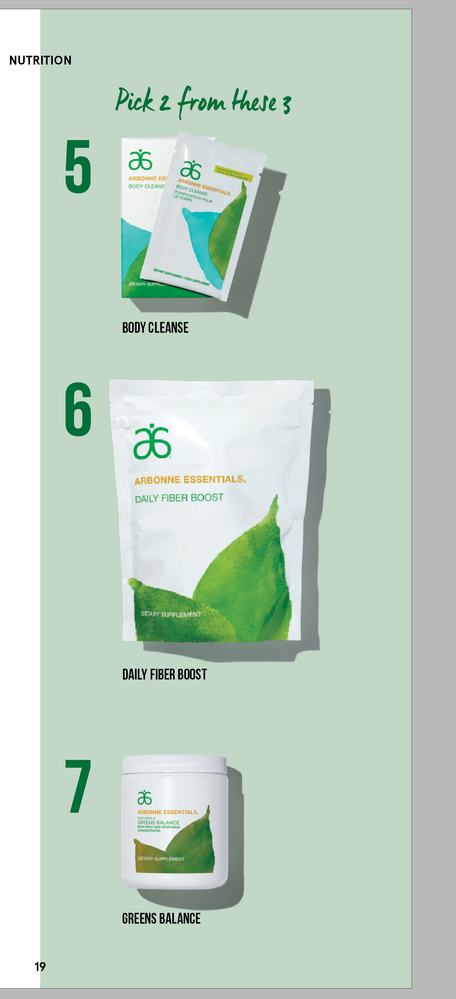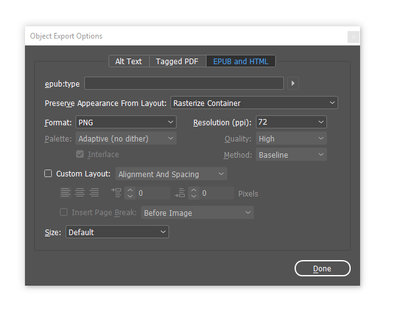"Multiply" effect in ePub
Copy link to clipboard
Copied
I have an ID doc with images set to "multiply" with an identical clipped image set to normal on top, all on top of a colored background. Creating a PDF and printing, image produces as expected. When exporting ID 2020 to ePub, the "multiply" setting is not respected and I'm getting the white background of the image. Any ideas on how to solve, or is this a limit of ePub? As you can see, also having font issues, but the developers tell me then can hard code that.
Copy link to clipboard
Copied
Some blend modes are not supported. Why not use PNGs with transparent backgrounds? And when you do, make sure to select PNG in the export dialog.
Copy link to clipboard
Copied
They are all PSD files placed. I'd rather not have to try to trace & create a clipping path on all of my product shadows. Not a good look.
Copy link to clipboard
Copied
Neither is a white box. Try forcing a PNG output or do the entire graphic in Photoshop.
Copy link to clipboard
Copied
One other thing. You pretty much have to use opentype fonts and beyond Books on iOS and Mac, fixed layout epub is a crapshoot.
Copy link to clipboard
Copied
Thanks Bob, not a practical solution for the return. We will have to convey that ePub is not ready to replace the printed word. 😄
Copy link to clipboard
Copied
Copy link to clipboard
Copied
To amend the answers given by Bob: blend modes are not directly supported by epubs, but will work in an epub when the objects (the foreground object(s) with the blend mode set and the background object(s) that is/are affected by that blend mode) are grouped, and the Object Export Options are changed as follows for that group:
The PPI should be set to 72ppi when using an iPad Retina document: the group will then be rasterized to the exact required resolution (do not use 150 or 300ppi, which will needlessly generate a much too high resolution image far exceeding the actual resolution of an ipad's screen).
Copy link to clipboard
Copied
I have the same problem and tried your grouping method, @rayek.elfin following all your settings. It didn't work. Maybe there's something else I should be doing? Here are the packaged indesign files, if that's helpful.
Copy link to clipboard
Copied
Group the bar and the images at the bottom. Then set the object export options for the group like this:
As you can see: it works.
Copy link to clipboard
Copied
Thank you so much for the quick response. Because my client needs this out asap, I altered the layout and removed the multiply opacity altogether from this page. I will check out your fix as soon as I have time. I am now focused on the fact that my document will not publish online (Adobe) even though it did so just yesterday!
Copy link to clipboard
Copied
My recommendation would be to use PSD but stop using clipping paths. Rather, make Layer Masks.
In testing your document, I see the InDesign document set to (Edit > Transparency Blend Space ) CMYK but it should be RGB? My experience with groups and epub is that InDesign 2023 v18 is able to handle the conversion to PNG and the alt text correctly.
Copy link to clipboard
Copied
Sorry Mike, but I think you are misunderstanding the issues related to epub export and blending/transparency effects here. This has nothing to do with clipping paths, layer masks, or blend space.
Copy link to clipboard
Copied
Old PostScript techniques and wrong base document blend space is definitely a factor. But in this thread the question shifted a bit from the OP. Your advice about grouping was sound and epub issues related to grouped objects has been improved in v18. The essence of my advice is to simplify the approach. That was also Bob's essential advice.
Copy link to clipboard
Copied
Yes, I agree the OP could have made things simpler by just removing the white background component from the images using a color to transparency filter to retain the transparent shadows.
But it's an old thread anyway.
Copy link to clipboard
Copied
In my recent (== reasonably current, since this is an old thread) experience, only PNG and GIF with properly defined transparency will consistently show that transparency in EPUB. Transparency applied to images through ID, image masks etc. often does not display.
(And transparency doesn't work, no how, no way, in Kindle. Just getting that in for future visitors.)
Copy link to clipboard
Copied
Any effect applied in InDesign can be made to work with an ePub, but it always involves grouping affected elements and rasterizing those parts with the export options.
So in effect merely turning everything into static PNGs (or jpg for background items).
It is actually a much better approach to avoid InDesign's built-in blending and effects (dropshadow, etc), because:
- the quality of the rasterization is out of the user's control
- the file size compression is out of the user's control
- elements that are rasterized this way cannot be animated
For example, if we need a dropshadow effect for text that affects other layout elements, a preferred workflow is to:
- create the dropshadow effect for the text in Photoshop
- isolate this dropshadow layer and export as a separate PNG file
- layer this underneath the text object in InDesign.
- Group both.
Text remains vector, and the dropshadow can be compressed much better, resulting in lower files sizes and the text is rendered as text.
Anway, most InDesign users are hardly aware of how InDesign and the export options work - let alone know when and why to use these or not to use these. When I show people what I achieve with FXL epub and animation effects, they assume that I used After Effects and converted the entire thing to a movie file. When I explain that it is mostly a clever application of various combined techniques, they are often stunned into silence. (PS In my work I am forced to use FXL epub - I prefer to use different tools for highly interactive media projects!)
As you @James Gifford—NitroPress have experienced yourself with epub creation in general: most people don't know what they don't know.
Nothing wrong with that as such. We all start out like that.
Find more inspiration, events, and resources on the new Adobe Community
Explore Now






